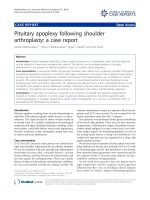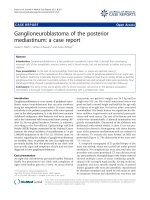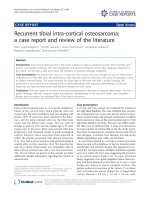Báo cáo y học: "Chondrosarcoma presenting as dyspnea in a 19-year-old man: a case report" pdf
Bạn đang xem bản rút gọn của tài liệu. Xem và tải ngay bản đầy đủ của tài liệu tại đây (665.61 KB, 4 trang )
CAS E REP O R T Open Access
Chondrosarcoma presenting as dyspnea in a
19-year-old man: a case report
Rajasekharan Chandrasekharan
*
, Mithun Chalakarayil Bhagavaldas and Ashish Jacob Mathew
Abstract
Introduction: Acute pulmonary embolism has varied presentations ranging from asymptomatic, incidentally
discovered emboli to massive embolism, causing immediate death. Tumor embolism is a rare but unique
complication of malignancies. This uncommon catastrophe of a malignant tumor in a young patient, culminating
as a pulmonary embolism, is being reported for the first time.
Case presentation: A 19-year-old Asian man presented to the emergency service at our hospital with acute onset
dyspnea. His clinical examination led to the suspicion of an acute pulmonary embolism with a lower lumbosacral
radiculopathy. A magnetic resonance imaging scan of the pelvis demonstrated a chondrosarcoma arising from the
right iliac wing, eroding into the common iliac vein and creeping up the inferior vena cava to lodge in the
pulmonary artery, thus producing a saddle embolus.
Conclusion: The importance of exploring for malignancies in the event of an idiopathic pulmonary embolism is
highlighted. Early detection of such malignancies can substantially affect the outcome in young patients.
Introduction
Detached thrombi or tumour may be the cause for mas-
sive pulmonary embolism in patients with malignanci es.
Identification of the type of pulmonary embolism is car-
dinal as the treatment and prognosis vary con side rably.
We report an unusual presentation of a tumour embo-
lism in a young man, who succumbed to the disease.
Case report
A 19-year-old Asian man, was admitted to the emer-
gency services (ES) at our hospital with acute onset of
severe breathlessness following a short duration of dry
cough, without any asso ciated fever, chest pain or
hemoptysis. He also had lower-back pain and right
lower limb weakness with paresthesia, which was attrib-
uted to an injury sustained while playing football. He
was prescrib ed analges ics and advised by an orthopedic
surgeon to take bed rest for his lower limb ailment. His
lower-back radiograph was norma l. On examination at
the ES, he had tachypnea and tachycardia with elevated
jugular venous pressure and was normotensive with no
pallor or pedal edema. His cardiovascular system
examination revealed a loud second heart sound and a
right ventricular third heart sound. His respiratory sys-
tem examination was normal. The examination of his
nervous system was suggestive of a right lower lumbosa-
cral (L3-S1) radiculopathy. A moderate, tender hepato-
megaly was detected in abdominal palpation. His oxygen
saturation in the ES was 92 percent at room air
temperature.
Initial blood inv estigations revealed leukocytosis with
neutrophilia and normal liver and renal function. An
acid base analysis showed compensated respiratory
acidosis. His chest radiograph revealed a wedge-shaped
opacity in the right midzone with dilated main pulmon-
ary artery and focal oligemia in the right lower zone,
which may have been suggestive of a pulmonary embo-
lism. High-resolution computed tomographic (HRCT)
imaging showed an acute, large, saddle embolus comple-
tely filling the left pulmonary artery and partly occluding
the right pulmonary artery, as well as multiple, detached
peripheral pulmonary artery thrombi in both the upper
and right lower lobes (Figure 1). Emergency echocardio-
graphy was performed, which revealed a large thrombus
at the main pulmonary artery bifurcation and extending
into the right and left pulmonary arteries. The right
atrium and main pulmonary artery were dilated.
* Correspondence:
Department of Internal Medicine, Medical College Hospital, Trivandrum,
Kerala, India
Chandrasekharan et al. Journal of Medical Case Reports 2011, 5:150
/>JOURNAL OF MEDICAL
CASE REPORTS
© 2011 Chandrasekharan et al; licensee BioMed Central Ltd. This is an O pen Access article distributed under the terms of the Creative
Commons Attribution License ( /licenses/by/2.0), which permits unrestricted use, distribu tion, and
reproduction in any medium, provided the original work is properly cited.
Considering the short duration of symptoms and the
massive size of the thrombus, thrombolysis was tried
with streptokinase followed by unfractionated heparin
infusion. On the second day of admission, the patient
developed hemoptysis and signs of deep vein thrombosis
in b oth the l ower limbs, an d his oxygen satura tion
dropped to 86% at room air temperature. A Doppler
ultrasound scan of both lower limbs demonstrated an
extensive acute thrombus involving the peroneal vein,
distal femoral vein, popliteal vein, the entire segment of
the external iliac vein, the common iliac vein on the
right side and the inferior vena c ava. As the thrombus
was refractory to thrombolysis therapy, a surgical embo-
lectomy of the pulmonary embolism was attempted, the
histopathological examination of which revealed a chon-
drosarcoma (Figure 2).
The postoperative period was uneventful, and his
symptoms subsided gradually. Because we suspected a
tumor embolism, his lower-back ache and paresthesia
were evaluat ed in detail. A magnetic resonance imaging
(MRI) scan of his spine and pelvis showed a large,
destructive mass lesion arising from the right iliac wing
with permeative lytic areas involving the right iliac vein
and a tumor embo lus within the inferior vena cava
(Figure 3). There were metastases involving the fourth
and fifth lumbar and first sacral vertebral bodies as well
as pedicles on the right side. An open biopsy was taken
from the iliac tumor, which confirmed the diagnosis
(Figure 4). We initiated palliative chemotherapy for the
patient. As there was no conclusive evide nce of throm-
boembolism, anticoagulation was deferred.
Discussion
Malignancy is one of the well-known risk factors for
pulmonary embolism. Rarely, embolism of the tumor
tissue itself or tumor cells can occlude the main pul-
monary artery or its large branches, causing dyspnea.
This is called tumor embolism and is exceedingly diffi-
cult to r ecognize before death. Autopsy series have esti-
mated the incidence of pulmonary tumor embolism to
be between 3% and 26% among patients with solid
tumors [1,2]. The majority of reported cases are in asso-
ciation with breast, stomach or lung carcinomas [3].
Chondrosarcomas, the third most common primary
malignancy of the bone, usually grow slowly and metas-
tasize [4]. In some cases, however, this course is altered
dramatically by a long-recognized feature of this tumor:
intravascular invasion.
Very few case reports have conf irmed the association
of tumor embolism and chondrosarcoma [5-7]. In the
case reported here, a pelvic chondrosarcoma was
responsible for the thrombus. The unusual feature of
this tumor was its transvenous spread involving the pel -
vic and retroperitoneal veins all the way to the inferior
Figure 1 High-resolution computed tomographi c image of the
patient’s chest showing the saddle embolus.
Figure 2 Pulmonary embolectomy specimen showing malignant chondrocytes.
Chandrasekharan et al. Journal of Medical Case Reports 2011, 5:150
/>Page 2 of 4
vena cava (Figure 3) and causing subsequent tumor
embolization. MRI and Doppler ultrasound scans
together could detect the invasion. No report of a major
case series of chondrosarcoma has discussed this
complication.
A good proportion of patients with tumor embolisms
already have widespread metastatic disease at the time
of presentation. Hence, there is a paucity of prospective
trials of chemotherapy in thesepatients.Thetreatment
options available in such situations are surgical embo-
lectomy and treatment of the primary tumor, which
includes wide en bloc excision, radiotherapy, palliative
car e and antiangiogenesis combined with chemotherapy
[4,8]. Few cases of successful chemotherapy of tumor
embolism have been described in the literature [9,10].
The most important decision involving a patient sus-
pected of having a tumor embolism is how aggressively
to pursue the diagnosis. An early confirmation of the
presence of tumor embolism may avoid unnecessary
anticoagulation and thrombolytic therapy, which are
absolute indications i n cases of thromboembolism.
There are also chances of complete remission of the
tumor if adequate chemotherapy is initiated well in
advance. The patient reported here showed symptomatic
improvement after surgery. However, the tumor had
already caused widespread damage. Hence, radiotherapy
had to be initiated, followed by palliation.
Conclusion
Occurrence of an acute pulmonary embolism in a can-
cer patient should always prime the clinician to search
for tumor thrombosis. The refractoriness of the throm-
bus to thrombolysis therapy, as in the reported case, is
yet another poi nter to tumor embolism. Whenever
chondrosarcoma of the pelvis is suspected in a young
patient, the possibility of extensive venous extension
should be considered and appropriate diagnostic tests
should be performed early to avoid unnecessary anticoa-
gulation and initiate appropriate chemotherapy.
Consent
Written informed consent was obtained from the
patient’s father for publication of this case report and
accompanying images. A copy of the written consent is
available for review by the Editor-in-Chief of this
journal.
Authors’ contributions
RC was the primary clinician and prepared the manuscript. MCB was the
resident in charge of the patient. AJM was the resident in the unit and
prepared the manuscript. All the authors have read and approved the final
manuscript.
Competing interests
The authors declare that they have no competing interests.
Received: 19 April 2010 Accepted: 15 April 2011
Published: 15 April 2011
References
1. Shields DJ, Edwards WD: Pulmonary hypertension attributable to
neoplastic emboli: an autopsy study of 20 cases and a review of the
literature. Cardiovasc Pathol 1992, 1:279-287.
2. Bast RC, Kufe DW, Pollock RE, Weichselbaum RR, Eds: Cancer Medicine. 5
edition. Hamilton, ON, Canada: B.C. Decker; 2000.
3. Roberts KE, Hamele-Bena D, Saqi A, Stein CA, Cole RP: Pulmonary tumour
embolism: a review of the literature. Am J Med 2003, 15:228-232.
4. Gelderblom H, Hogendoorn PCW, Dijkstra SD, van Rijswijk CS, Krol AD,
Taminiau AHM, Bovée JV: The clinical approach towards chondrosarcoma.
Oncologist 2008, 13:320-329.
5. Hayashida K, Nishimura T, Uehara T, Naito H, Takamiya M, Kozuka T,
Sakakibara H, Imakita M, Yutani C, Hamada T: [A case of pulmonary tumor-
embolism from chondrosarcoma of the lower extremity] (in Japanese).
Kaku Igaku 1985, 22:101-106.
6. Leung DY, Seah PW, Lee LC, Cranney GB, Walsh WF: Embolic
chondrosarcoma: an unusual cause of pulmonary embolism. Am Heart J
1993, 126:732-734.
Figure 3 Magnetic resonance imaging scan showing tumor
embolus within the inferior vena cava.
Figure 4 Specimen from the iliac bone showing malignant
chondrocytes.
Chandrasekharan et al. Journal of Medical Case Reports 2011, 5:150
/>Page 3 of 4
7. Yoshida K, Miyashita N, Nakajima M, Niki Y, Matsushima T: [A case of
sternal chondrosarcoma with multiple pulmonary embolisms] (in
Japanese). Nihon Kokyuki Gakkai Zasshi 2002, 40:166-170.
8. Morioka H, Weissbach L, Vogel T, Nielsen GP, Faircloth GT, Shao L,
Hornicek FJ: Antiangiogenesis treatment combined with chemotherapy
produces chondrosarcoma necrosis. Clin Cancer Res 2003, 9:1211-1217.
9. Kosugi M, Ono T, Yamaguchi H, Sato N, Dan K, Tanaka K, Takano T:
Successful treatment of primary cardiac lymphoma and pulmonary
tumor embolism with chemotherapy. Int J Cardiol 2006, 111:172-173.
10. Wong PS, Aye WMM, Lee CN: Pulmonary tumor embolism secondary to
osteosarcoma. Ann Thorac Surg 2004, 77:341.
doi:10.1186/1752-1947-5-150
Cite this article as: Chandrasekharan et al.: Chondrosarcoma presenting
as dyspnea in a 19-year-old man: a case report. Journal of Medical Case
Reports 2011 5:150.
Submit your next manuscript to BioMed Central
and take full advantage of:
• Convenient online submission
• Thorough peer review
• No space constraints or color figure charges
• Immediate publication on acceptance
• Inclusion in PubMed, CAS, Scopus and Google Scholar
• Research which is freely available for redistribution
Submit your manuscript at
www.biomedcentral.com/submit
Chandrasekharan et al. Journal of Medical Case Reports 2011, 5:150
/>Page 4 of 4









